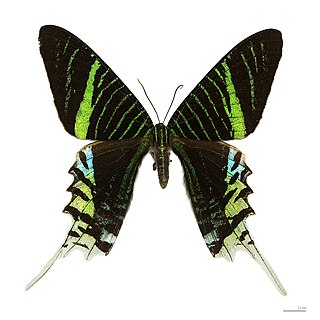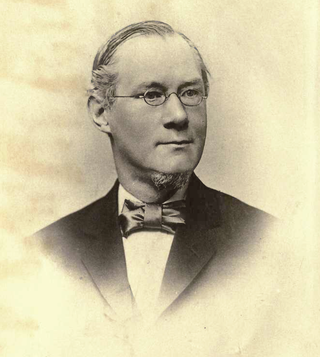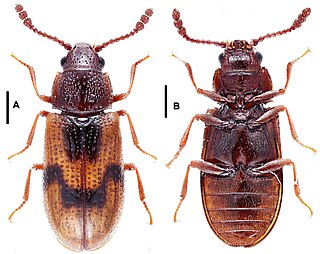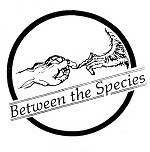
The International Union for Conservation of Nature (IUCN) Red List of Threatened Species, also known as the IUCN Red List or Red Data Book, founded in 1964, is an inventory of the global conservation status and extinction risk of biological species. A series of Regional Red Lists, which assess the risk of extinction to species within a political management unit, are also produced by countries and organizations.

The Old World flycatchers are a large family, the Muscicapidae, of small passerine birds restricted to the Old World, with the exception of several vagrants and two species, bluethroat and northern wheatear, found also in North America. These are mainly small arboreal insectivores, many of which, as the name implies, take their prey on the wing. The family is relatively large and includes 351 species which are divided into 54 genera.
The pelagic zone consists of the water column of the open ocean and can be further divided into regions by depth. The word pelagic is derived from Ancient Greek πέλαγος (pélagos) 'open sea'. The pelagic zone can be thought of as an imaginary cylinder or water column between the surface of the sea and the bottom. Conditions in the water column change with depth: pressure increases; temperature and light decrease; salinity, oxygen, micronutrients all change. Somewhat analogous to stratification in the Earth's atmosphere, but depending on how deep the water is, the water column can be divided vertically into up to five different layers.

Crambidae comprises the grass moth family of lepidopterans. They are variable in appearance, with the nominal subfamily Crambinae taking up closely folded postures on grass stems where they are inconspicuous, while other subfamilies include brightly coloured and patterned insects that rest in wing-spread attitudes.

The Uraniidae are a family of moths containing four subfamilies, 90 genera, and roughly 700 species. The family is distributed throughout the tropics of the Americas, Africa and Indo-Australia. Some of the tropical species are known for their bright, butterfly-like colors and are called sunset moths. Such moths are apparently toxic and the bright colors are a warning to predators.

Anton Reichenow was a German ornithologist and herpetologist.
The Handbook of the Birds of the World (HBW) is a multi-volume series produced by the Spanish publishing house Lynx Edicions in partnership with BirdLife International. It is the first handbook to cover every known living species of bird. The series was edited by Josep del Hoyo, Andrew Elliott, Jordi Sargatal and David A. Christie.
Francis Polkinghorne Pascoe was an English entomologist mainly interested in beetles.

Pierre François Marie Auguste Dejean, was a French soldier and entomologist. Dejean described a large number of beetles in a series of catalogues.

The flora of India is one of the richest in the world due to the wide range of climate, topology and habitat in the country. There are estimated to be over 18,000 species of flowering plants in India, which constitute some 6-7 percent of the total plant species in the world. India is home to more than 50,000 species of plants, including a variety of endemics. The use of plants as a source of medicines has been an integral part of life in India from the earliest times. There are more than 3000 Indian plant species officially documented as possessing into eight main floristic regions : Western Himalayas, Eastern Himalayas, Assam, Indus plain, Ganges plain, the Deccan, Malabar and the Andaman Islands.
The Flora of North America North of Mexico is a multivolume work describing the native plants and naturalized plants of North America, including the United States, Canada, St. Pierre and Miquelon, and Greenland. It includes bryophytes and vascular plants. All taxa are described and included in dichotomous keys, distributions of all species and infraspecific taxa are mapped, and about 20% of species are illustrated with line drawings prepared specifically for FNA. It is expected to fill 30 volumes when completed and will be the first work to treat all of the known flora north of Mexico; in 2015 it was expected that the series would conclude in 2017. Twenty-nine of the volumes have been published as of 2022.
Tritons are a fictional species in the Dungeons & Dragons fantasy role-playing game.

Tree allometry establishes quantitative relations between some key characteristic dimensions of trees and other properties. To the extent these statistical relations, established on the basis of detailed measurements on a small sample of typical trees, hold for other individuals, they permit extrapolations and estimations of a host of dendrometric quantities on the basis of a single measurements.

George Washington Tryon Jr. was an American malacologist who worked at the Academy of Natural Sciences in Philadelphia.
Flora of China is a scientific publication aimed at describing the plants native to China.

Alexiidae is a family of beetles. It contains a single genus, Sphaerosoma, formerly included within the family Cerylonidae, with around 50 species which are native to the western Palearctic. Species of Sphaerosoma are very small, around 1 to 2 mm in length rounded beetles with clubbed antennae. They are fungivores, having been observed feeding on mushrooms, and have also been found in leaf litter and on decaying bark.

Lamingtonium is the only genus in the family Lamingtoniidae, of the beetle superfamily Cucujoidea. It contains three species endemic to Australia. The holotype of the type species was collected on at Lamington National Park, Binna Burra, Queensland under the bark of a dead tree. The adults and larvae of two species have been found associated with basidiocarps of fungi belonging to the family Polyporaceae.
The Australian Faunal Directory (AFD) is an online catalogue of taxonomic and biological information on all animal species known to occur within Australia. It is a program of the Department of Climate Change, Energy, the Environment and Water of the Government of Australia. By May 12, 2021, the Australian Faunal Directory has collected information about 126,442 species and subspecies. It includes the data from the discontinued Zoological Catalogue of Australia and is regularly updated. Started in the 1980s, it set a goal to compile a "list of all Australian fauna including terrestrial vertebrates, ants and marine fauna" and create an "Australian biotaxonomic information system". This important electronic key and educative package enables faster and orderly identification of Australian centipede species.

Acanthocnemus nigricans is a species of cleroid beetle, the only species in the genus Acanthocnemus and the family Acanthocnemidae. Originally native to Australia, the species has spread in modern times to numerous parts of the world, including Europe, Africa, India and Southeast Asia. The insects are pyrophilous, congregating around areas of recently burned wood, being attracted to chemicals found in wood smoke. They have specialised infrared receptors located on the thorax close to the head, used to detect heat. Their life cycle is poorly understood, though mating and egg-laying likely occurs within ash. The larvae are possibly saprophagous.

Between the Species: A Journal for the Study of Philosophy and Animals is a peer-reviewed academic journal devoted to philosophical examinations of human relationships with other animals. It is, in part, a continuation of Ethics & Animals (E&A), a journal which ran from 1980 to 1984. Between the Species was founded as a print journal in 1985, published by the Schweitzer Center of the San Francisco Bay Institute/Congress of Cultures. The print version ceased publication in 1996. It was revived as an open access online-only journal in 2002. It is published by the Philosophy Department and Digital Commons at the California Polytechnic State University; Joseph Lynch is the current editor-in-chief.













